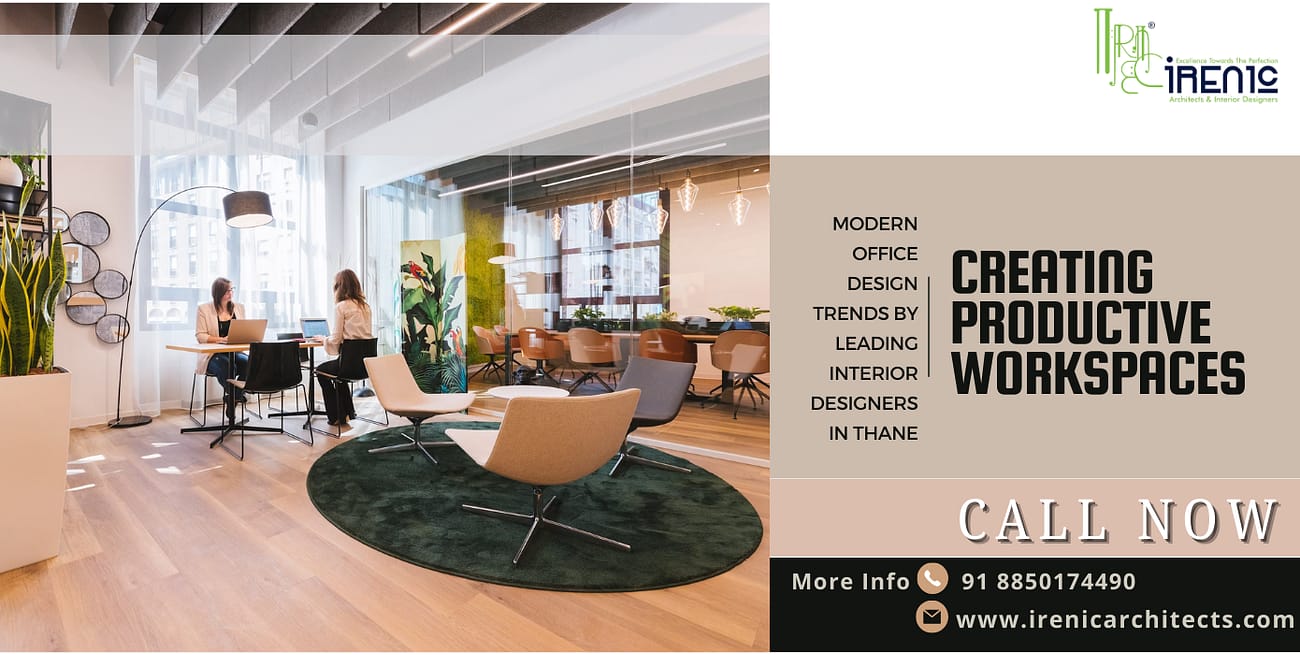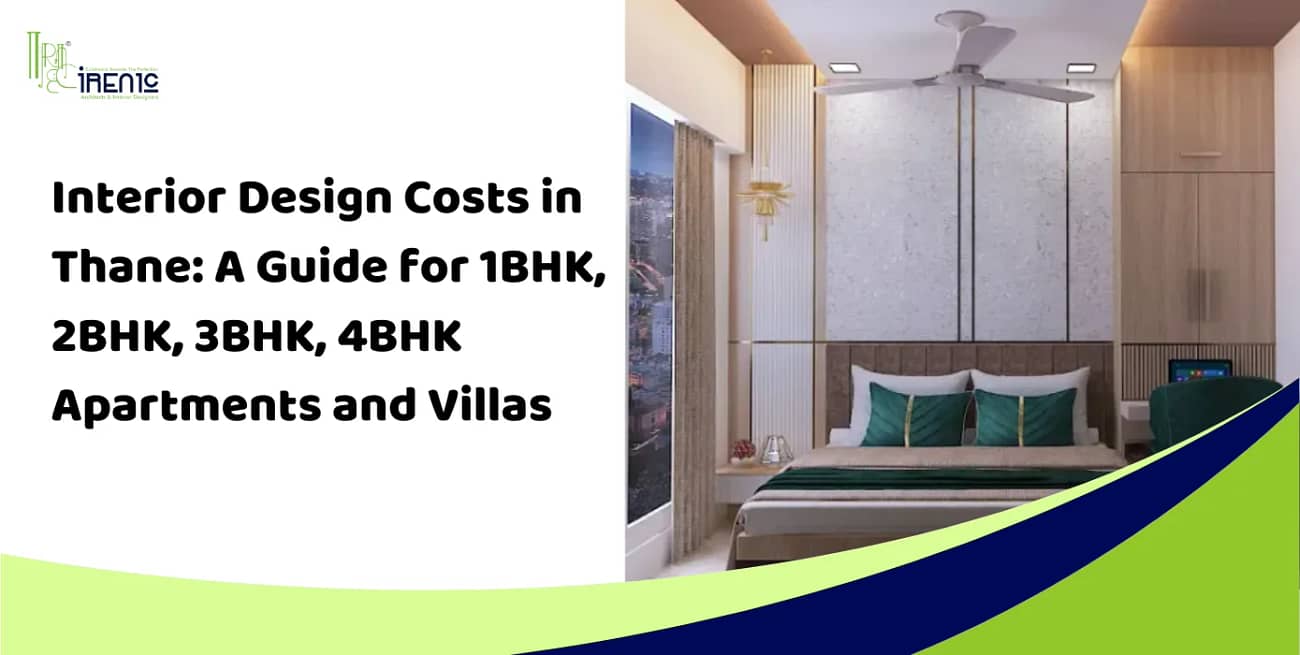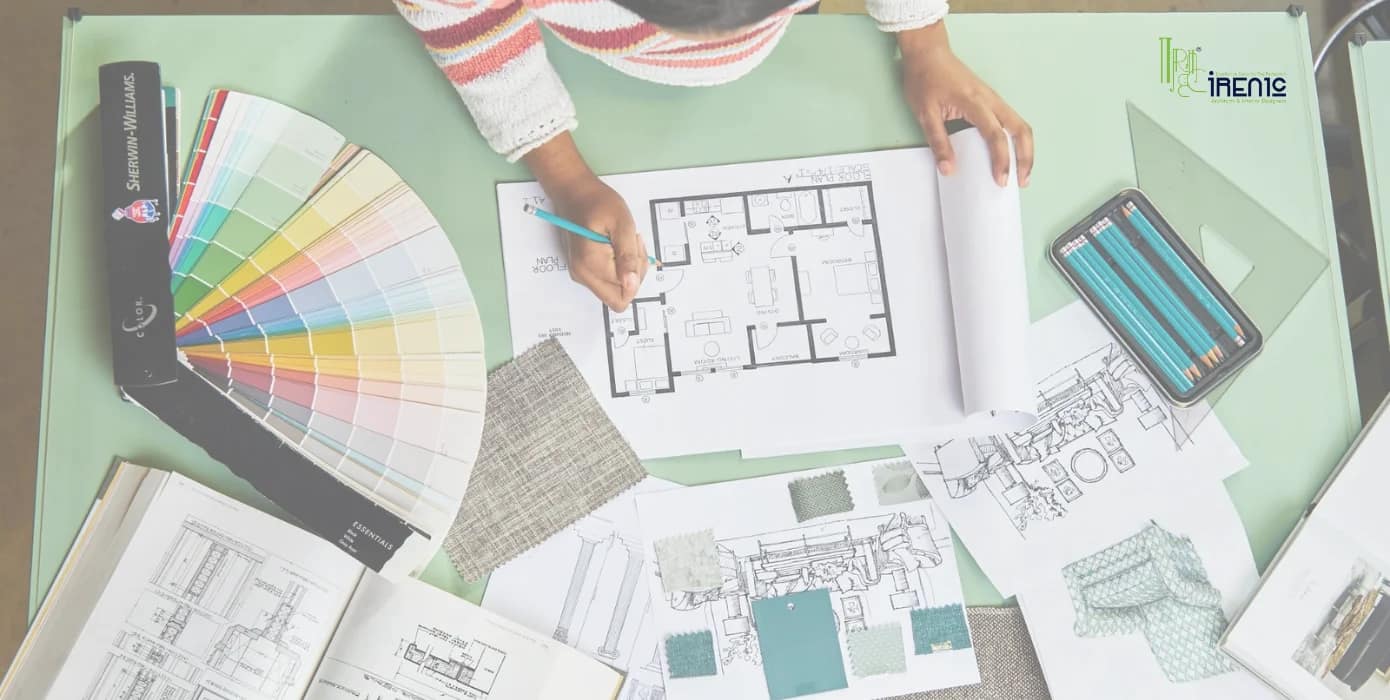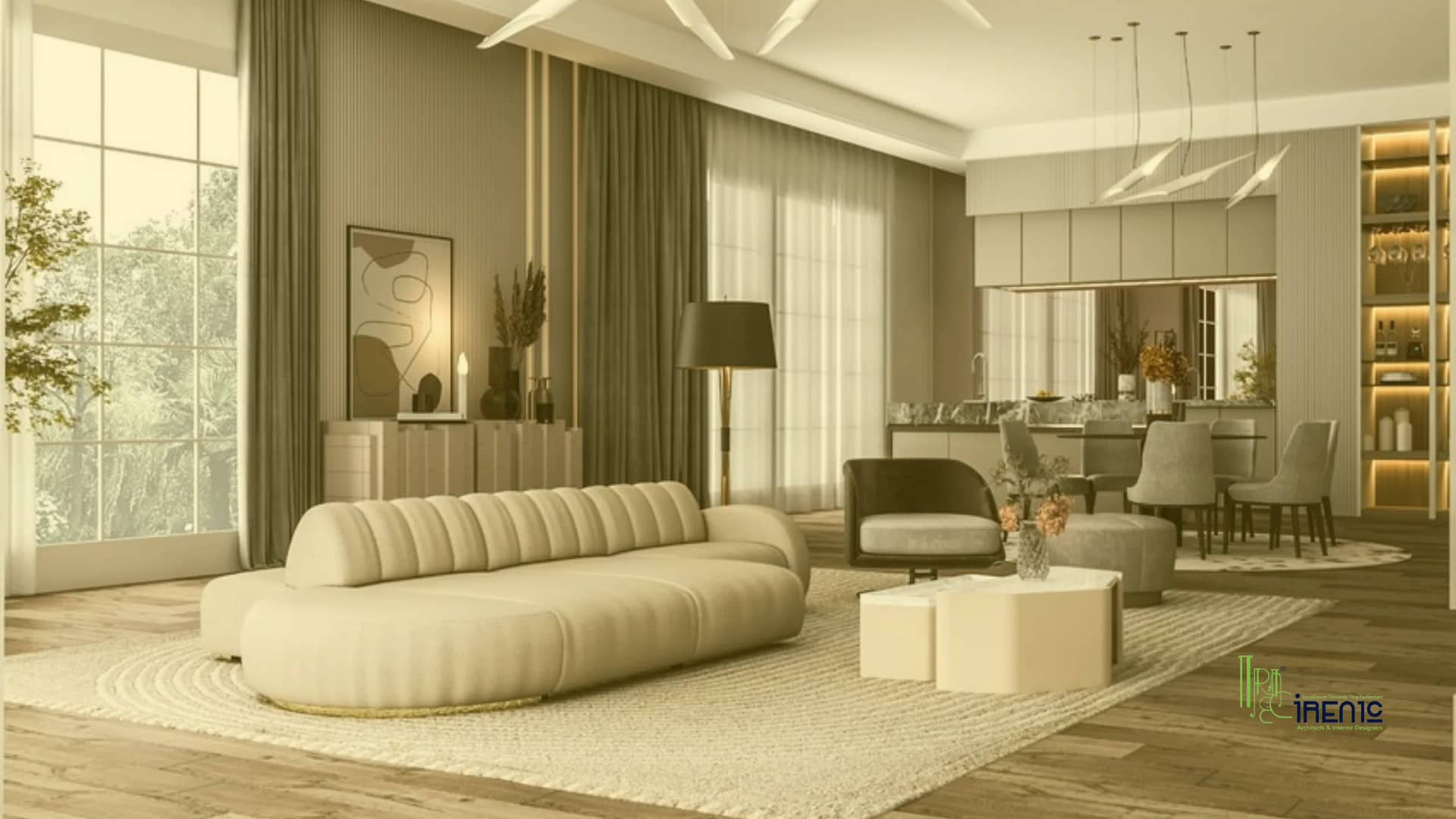In today’s fast-paced corporate world, the design of office spaces plays a crucial role in enhancing productivity and employee well-being. As businesses in Thane strive to create environments that foster creativity and efficiency, the expertise of Irenic Architects and Interior Designers comes to the forefront. Recognized as one of the best interior designers in Thane, they are leading the way in transforming commercial spaces with innovative and functional designs. Here, we explore some of the modern office design trends in Thane championed by these Thane interior design experts.
Modern Office Design Trends: Open Plan Layouts Encouraging Collaboration and Flexibility
Open-plan offices have become a hallmark of contemporary workspace design. By eliminating walls and partitions, these layouts encourage collaboration and communication among team members. Irenic Architects and Interior Designers, known for their innovative approach, emphasize creating spacious and flexible environments that can adapt to the dynamic needs of modern businesses. The absence of physical barriers fosters a sense of openness and accessibility, making it easier for employees to interact, share ideas, and work together seamlessly. This design approach not only boosts team morale but also enhances overall productivity by facilitating smoother workflows and faster decision-making.

Trending Style Options:
Hot Desking: Allows employees to choose their workstation each day, promoting flexibility and reducing the need for assigned desks.
Activity-Based Working: Designates different areas for specific tasks, such as quiet zones for focused work and open areas for collaborative projects.
Open Lounges: Creating lounge areas within open spaces for informal meetings and relaxation.
Recommendations:
Furniture on Wheels: Use mobile furniture to easily reconfigure the space as needed.
Sound Absorption Panels: Incorporate acoustic panels to manage noise levels in open-plan areas.
Zoning with Rugs and Furniture: Use rugs and different furniture arrangements to define distinct areas within the open plan.
Modern Office Design Trends: Biophilic Design Elements – Bringing Nature Indoors
Integrating natural elements into office interiors, known as biophilic design, is gaining popularity. This trend involves incorporating plants, natural light, and organic materials to create a calming and inspiring atmosphere. Thane commercial interior designers are adept at blending greenery and natural textures to bring the outdoors inside, enhancing employee well-being and productivity. The presence of plants and natural light has been shown to reduce stress, increase creativity, and improve air quality, making biophilic design a key component of modern office environments.

Trending Style Options:
Living Walls: Vertical gardens that can be installed on office walls to add greenery without taking up floor space.
Natural Light Optimization: Use of large windows, skylights, and glass partitions to maximize natural light.
Indoor Water Features: Small fountains or water walls to add a soothing element to the workspace.
Guidelines:
Desk Plants: Encourage employees to keep small plants on their desks for personal greenery.
Nature-Inspired Decor: Use natural materials like wood and stone in furniture and decor.
Natural Light Maximization: Arrange desks and workstations near windows to maximize exposure to natural light.
Modern Office Design Trends: Ergonomic Furniture for Health and Productivity
Investing in ergonomic furniture is essential for creating a comfortable and healthy work environment. Award-winning interior designers in Thane focus on selecting adjustable chairs, sit-stand desks, and other ergonomic solutions that support good posture and reduce the risk of musculoskeletal issues. These thoughtful design choices contribute to a more productive and satisfied workforce. Ergonomic furniture not only helps in preventing health problems but also enhances employee comfort, leading to increased focus and efficiency throughout the workday.

Trending Style Options:
Sit-Stand Desks: Desks that can be adjusted for sitting or standing to encourage movement throughout the day.
Ergonomic Chairs: Chairs with adjustable features such as lumbar support, seat height, and armrests.
Footrests and Keyboard Trays: Additional ergonomic accessories to ensure proper posture and comfort.
Advice:
Monitor Stands: Use adjustable monitor stands to ensure screens are at eye level.
Footrests: Provide footrests to improve sitting posture and comfort.
Regular Breaks: Encourage employees to take regular breaks to stand up, stretch, and move around.
Modern Office Design Trends: Advanced Technology Enhancing Efficiency
Modern office design must accommodate the ever-evolving technological landscape. Thane modern interior decorators ensure that workspaces are equipped with the latest tech amenities, such as smart lighting, wireless charging stations, and integrated audiovisual systems. These innovations streamline daily operations and support a seamless workflow. By incorporating advanced technology, designers create environments that are not only functional but also future-proof, capable of adapting to new tools and systems as they emerge.
Trending Style Options:
Smart Lighting Systems: Lighting that can be controlled via apps or voice commands, with settings for different times of day.
Wireless Charging Stations: Built-in charging stations in desks and communal areas for convenient device charging.
Integrated AV Systems: Wireless audiovisual systems for easy setup and use in meeting rooms.
Best Practices:
Tech Hubs: Create dedicated areas for technology, such as charging stations and digital collaboration tools.
Cable Management: Use cable management solutions to keep workspaces tidy and free from clutter.
Digital Whiteboards: Incorporate digital whiteboards for interactive presentations and brainstorming sessions.
Modern Office Design Trends: Collaborative Spaces Fostering Teamwork
In addition to individual workstations, collaborative spaces are essential for fostering teamwork and innovation. Thane interior design experts create multifunctional areas like breakout rooms, lounges, and meeting pods that encourage brainstorming and informal discussions. These spaces are designed to be flexible and can be easily reconfigured to suit various group activities. Collaborative areas provide employees with the opportunity to engage in spontaneous interactions, share knowledge, and develop creative solutions, driving innovation and team cohesion.

Trending Style Options:
Modular Furniture: Flexible furniture that can be reconfigured for different types of meetings and activities.
Interactive Whiteboards: Digital whiteboards that allow for interactive brainstorming and note-taking.
Soft Seating Areas: Comfortable seating arrangements for informal meetings and collaborative sessions.
Insights:
Breakout Areas: Design small, informal spaces with comfortable seating for quick team huddles.
Meeting Pods: Use acoustic pods for private, focused meetings within an open-plan office.
Flexible Layouts: Ensure that collaborative spaces can be easily reconfigured to accommodate different team sizes and activities.
Sustainable Practices: Promoting Eco-friendliness
Sustainability is a key consideration in modern office design. Leading interior designers in Thane prioritize the use of eco-friendly materials, energy-efficient lighting, and sustainable construction practices. By incorporating green design principles, they help businesses reduce their environmental footprint while creating a healthier work environment. Sustainable office designs not only benefit the planet but also enhance the company’s reputation and appeal to environmentally conscious employees and clients.
Trending Style Options:
Recycled Materials: Use of recycled and upcycled materials for furniture and decor.
Energy-Efficient Lighting: LED lighting and smart sensors to reduce energy consumption.
Green Certifications: Aim for certifications like LEED or WELL to validate your sustainable design efforts.
Strategies:
Waste Reduction: Implement recycling programs and use sustainable products to minimize waste.
Eco-Friendly Furniture: Choose furniture made from sustainable materials such as bamboo, reclaimed wood, and recycled metals.
Energy Management Systems: Use smart energy management systems to monitor and reduce energy consumption.
Personalized and Branded Spaces: Reflecting Identity
Reflecting a company’s culture and brand identity in the office design is becoming increasingly important. Thane commercial interior designers work closely with businesses to incorporate brand colors, logos, and unique design elements that resonate with the company’s values and mission. Personalized spaces not only enhance brand recognition but also instill a sense of pride and belonging among employees. By creating a visually cohesive and branded environment, companies can strengthen their identity and foster a deeper connection with their team.

Trending Style Options:
Custom Wall Art: Murals and artwork that reflect the company’s values and culture.
Brand Colors and Logos: Incorporate brand colors and logos into furniture, walls, and decor.
Themed Meeting Rooms: Design meeting rooms with themes that reflect different aspects of the company’s culture.
Suggestions:
Employee Input: Involve employees in the design process to create a space that reflects their needs and preferences.
Flexible Branding: Use interchangeable elements like vinyl graphics to update branding as needed.
Showcase Achievements: Display company awards, milestones, and success stories prominently to boost morale and pride.
How Irenic Architects and Interior Designers Lead the Way
Irenic Architects and Interior Designers, one of the leading interior design firms in Thane, have been at the forefront of incorporating these modern office design trends into their projects. Here’s how they do it:
Eco-friendly and Locally Sourced Materials: Prioritize materials that reduce transportation emissions and support local economies.
Energy-efficient Systems and Appliances: Ensure that spaces are beautiful and cost-effective in the long run.
Flexibility and Longevity: Focus on creating spaces that can adapt to changing needs.
Client Education: Educate clients on sustainable living benefits and help them make informed choices.
Why Choose Irenic Architects and Interior Designers?
Irenic Architects and Interior Designers stand out as one of the leading interior design firms in Thane, renowned for their expertise and creativity. Their innovative approach ensures that each project they undertake is not only aesthetically pleasing but also highly functional. Recognized as some of the best interior designers in Thane, they are known for delivering high-quality office spaces that enhance productivity and employee well-being.
As Thane modern interior decorators, they stay ahead of the curve by integrating the latest trends and technologies into their designs. This commitment to staying current allows them to create cutting-edge workspaces that meet the evolving needs of modern businesses. Their comprehensive services cover every aspect of the design process, from initial planning and conceptualization to execution and final touches.
Conclusion
Creating productive and inspiring workspaces requires a blend of creativity, functionality, and an understanding of the latest design trends. Irenic Architects and Interior Designers, recognized as one of the best interior designers in Thane, excel in transforming commercial spaces into hubs of innovation and efficiency. By embracing open-plan layouts, biophilic design, ergonomic furniture, technology integration, collaborative spaces, sustainable practices, and personalized designs, these Thane interior design experts are setting new standards in modern office design.
For businesses looking to revamp their office environments, partnering with award-winning interior designers in Thane ensures a workspace that not only meets the demands of today but also inspires success for the future. With their extensive experience, innovative approach, and commitment to sustainability, Irenic Architects and Interior Designers create office spaces that are both functional and aesthetically pleasing, fostering a productive and healthy work environment.
For more information on their services and to see how they can transform your workspace, visit Irenic Architects and Interior Designers. To stay updated with the latest trends and insights in interior design, check out their blog page.























